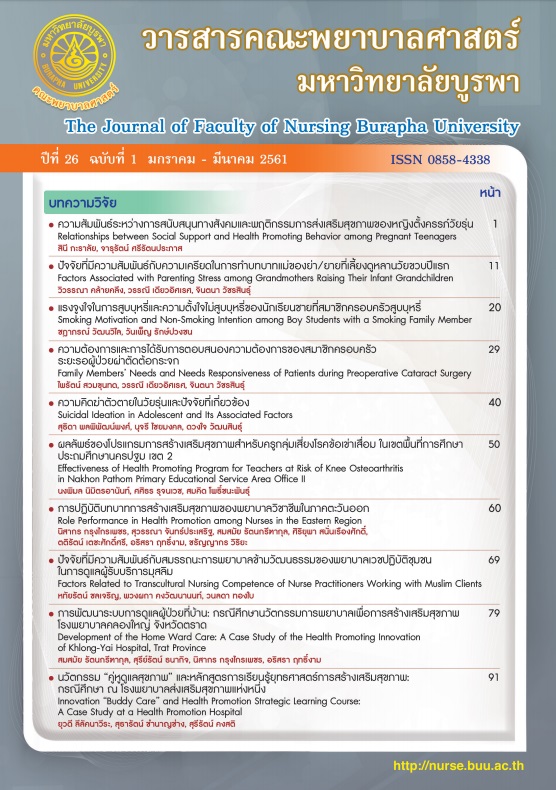ความคิดฆ่าตัวตายในวัยรุ่นและปัจจัยที่เกี่ยวข้อง
คำสำคัญ:
ความคิดฆ่าตัวตาย, วัยรุ่น, พฤติกรรมที่เป็นปัญหา, การมีปัญหากับนักเรียนอื่น, การมีปัญหากับครูอาจารย์บทคัดย่อ
บทคัดย่อ
การวิจัยแบบหาความสัมพันธ์เชิงทำนายครั้งนี้ มีวัตถุประสงค์ เพื่อศึกษาความคิดฆ่าตัวตายในวัยรุ่นและปัจจัยที่เกี่ยวข้อง ประกอบด้วย เพศ คุณลักษณะส่วนบุคคล และเหตุการณ์ความเครียดในชีวิต กลุ่มตัวอย่างคัดเลือกโดยการสุ่มแบบหลายขั้นตอน เป็นนักเรียนระดับชั้นมัธยมศึกษา ปีที่ 1 – 6 ของโรงเรียนระดับมัธยมแห่งหนึ่ง ในจังหวัดระยอง จำนวน 249 คน เก็บข้อมูลเดือนพฤษภาคม พ.ศ. 2560 เครื่องมือที่ใช้ในการวิจัย ได้แก่ แบบสอบถามข้อมูลทั่วไป แบบวัดความคิดฆ่าตัวตาย แบบประเมินจุดแข็งจุดอ่อน และแบบประเมินเหตุการณ์ความเครียดในชีวิต วิเคราะห์ข้อมูลโดยใช้สถิติพรรณนา และการวิเคราะห์ถดถอยไบนารี
ผลการศึกษาพบว่า วัยรุ่นกลุ่มตัวอย่างมีความเสี่ยงสูงต่อการมีความคิดฆ่าตัวตาย (Mean = 7.08, S.D. = 4.91) กลุ่มตัวอย่างที่มีเหตุการณ์ความเครียดในชีวิต คือมีปัญหากับนักเรียนอื่นและมีปัญหากับครู/อาจารย์ มีโอกาสมีความคิดฆ่าตัวตายมากเป็น 3.7 เท่า ของผู้ที่ไม่มีปัญหากับนักเรียนอื่น (OR = 3.65, CI = 1.53 - 8.73) และ 2.2 เท่าของผู้ที่ไม่มีปัญหากับครู/อาจารย์ (OR = 2.21, CI = 1.15 - 4.23) นอกจากนี้ ผู้ที่มีพฤติกรรมที่เป็นปัญหามีโอกาสมีความคิดฆ่าตัวตายมากเป็น 2.4 เท่า ของผู้ที่ไม่มีพฤติกรรมที่เป็นปัญหา (OR = 2.36, CI = 1.17 - 4.74) ผลการวิจัยครั้งนี้ ให้ข้อเสนอแนะว่าพยาบาลและผู้มีหน้าที่เกี่ยวข้องในการดูแลสุขภาพวัยรุ่น ควรนำผลการวิจัยนี้ไปใช้เป็นข้อมูลในการวางแผนจัดกิจกรรมหรือโปรแกรมเพื่อส่งเสริมการมีพฤติกรรมสังคมทางบวก รวมทั้งสนับสนุนการมีสัมพันธภาพที่เหมาะสมระหว่างเพื่อนนักเรียนและครู/อาจารย์ เพื่อลดและป้องกันการมีความคิดฆ่าตัวตายในวัยรุ่น
เอกสารอ้างอิง
reported suicidality and its predictor among adolescents from a
pre-university college in Bangalore. India Asian Journal of Psychiatry,
7, 38-45.
Boonyamalik, P. (2005). Epidemiology of adolescent suicidal ideation: Roles of
perceived life stress, depressive symptoms, and substance use (Thailand).
Doctoral Dissertation, Mental Health, Johns Hopkins University, USA. (in Thai)
Centers for Disease Control and Prevention [CDC]. (2016). Definitions: Self-directed
violence. Retrieved from http://www.cdc.gov/violenceprevention/suicide/ definitions.html http://www.cdc.gov/violenceprevention/suicide/ definitions.html
Dallas, J. C., Puapan, S., Vatanasin, D. (2015). Factors Influencing mental health status among nursing students. The Journal of Faculty of Nursing Burapha University 23 (3), 1 – 13 (in Thai)
Department of Mental Health. (2003). The strength and difficulties questionnaire
(SDQ). Retrieved from http://www.cumentalhealth.com.
Department of Mental Health. (2010). Reported case of suicide per 100,000
population by Province Thailand. Retrieved from http://www.dmh.go.th/
plan/suicide.
Harrell, F. E. (2001). Regression modeling strategies: With application to linear model,
logistic regression, and survival analysis. New York City Stat Spring.
Kittiteerasack, P., Muijeen, K. (2015). Psychometric properties of the Thai version of the Scale For Suicidal Ideation (SSI-THAI VERSION 2014). Thai Journal Citation Index Center, 29(1), 93-102. (in Thai)
Liu, R. T., & Miller, I. (2014). Life events and suicidal ideation and behavior: A
systematic review. Clinical Psychology Review, 34(3), 181-192.
Murray, C., & Greenburg, M. T., (2001). Relationship with teachers and bonds with
school: Social emotion adjustment correlates for children with and without
disability. Psychology in School, 38(1), 25-45.
Prateepteranan, W. (2014). The rate of suicide and factors related to suicidal behavior
at Chaophayommarat Hospital Suphanburi Province. Thai Journal Citation
Index Center, 28(3), 90-103. (in Thai)
Rudd, M. D. (2004). Cognitive therapy for sociality: An integrative, comprehensive, and
practical approach to conceptualization. Journal of Contemporary
Psychotherapy, 34, 59-72.
Rungsang, B. (2016). Suicidal ideation among Thai adolescents: An empirical test of a
causal model. A dissertation submitted in partial fulfillment of the
requirement for the doctor degree of philosophy in nursing science, Faculty
of Nursing, Burapha University.
Rungsang, B., Chaimongkol, N., Deoisres, W., and Wongnam, P. (2017). Suicidal
ideation among Thai adolescents: An Empirical Test of a causal Model.
Pacific Rim International Journal of Nursing Research, 21(2) 97 – 107





